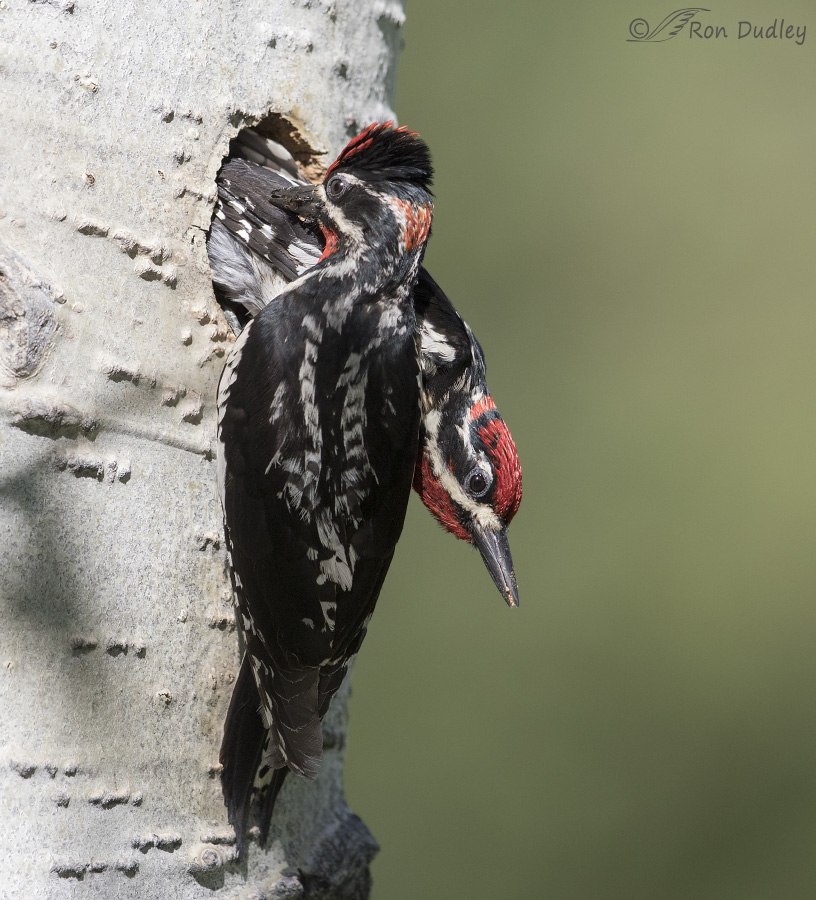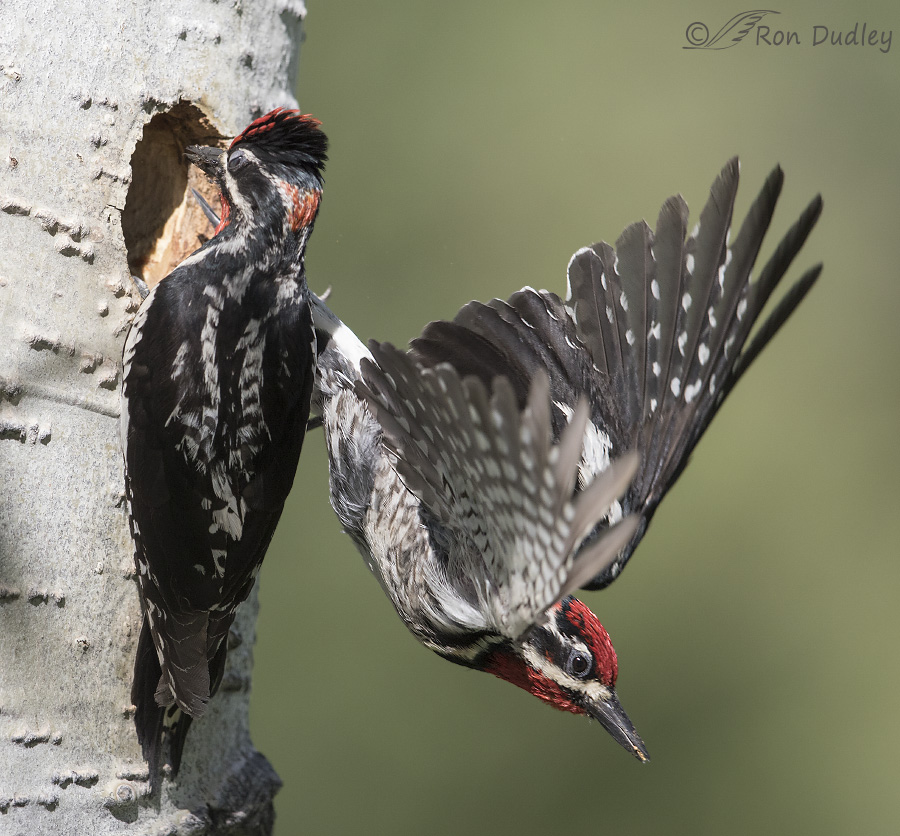Yesterday morning I photographed a pair of Red-naped Sapsuckers as they attended to familial duties at their nest cavity in the Uinta Mountains. Shooting conditions were very difficult due to constantly changing light and the high contrast between the almost white aspen bark and the blacks of the birds but I did get some images I like.

1/3200, f/5, ISO 640, Canon 7D Mark II, Canon EF 500mm f/4L IS II USM + 1.4 tc, not baited, set up or called in
They spent much of their time hauling sap-dipped ants to their offspring and removing wood chips and fecal sacs from inside the cavity. Often when one parent arrived at the nest entrance the other one was already inside the cavity so that bird would have to leave before the arriving adult could enter.
That’s what’s happening here – the male (I believe) with a few wood chips in his bill is making his exit while the female waits at the entrance with a beak full of ants for the chicks. These exits are explosively fast so I was lucky…

1/3200, f/5, ISO 640, Canon 7D Mark II, Canon EF 500mm f/4L IS II USM + 1.4 tc, not baited, set up or called in
to have not clipped any body parts in the next image in the burst. The female’s eye is half closed but I still have a catch light in the eye to partially make up for it.
This nest cavity was a lucky find. I won’t photograph nesting birds if my presence disrupts their normal behavior in any way but this nest tree is within a couple of feet of a busy paved road and these sapsuckers are oblivious to the fairly steady stream of traffic including large noisy trucks. They have become completely acclimated to all the human hubbub and they simply ignored the presence of my pickup (as per usual I was shooting from inside my truck and using a super-telephoto lens).
One of the reasons I enjoy photographing birds in challenging conditions like this is that I learn so much about the capabilities and limitations of my gear and my own photography skills.
And believe me, I learned a lot yesterday.
Ron


What sensational shots Ron! Thanks for sharing!
Charlotte
There are so many species (and sap-suckers are one of them) I learned about from you. And that I look forward to seeing each year. Megathanks.
Parenting is not an easy job. And parenting in confined spaces would drive me (more) bat-shit crazy. And, as an aside, just what IS so crazy about bat shit.
EC, I can only imagine how many Australian species I could learn about from you – including those infamous snakes that you don’t trust.
Very beautiful! I am struggling with bright whites and blacks. I either blow out white feathers or my blacks are so black all definition is lost. I am having a hard time finding a happy medium.
Me too April!
We all struggle in those situations, April (and Dick). Sometimes the image can’t be saved but exposure adjustments in post processing can help significantly if there’s any detail at all in the blacks and whites.
Harsh light exaggerates the problem which is one of the reasons I’m nearly always shooting in the early morning (or late afternoon).
You’ll notice that there’s very little detail in the blacks of the lower back of the female in this second photo and that’s after I worked with it in processing. I also took the bright whites on the male’s rump out of my sharpening mask because sharpening increases brightness a little and those whites were already bright and there’s not much detail there to sharpen anyway.
And I should have removed some of the feathers below those whites from the sharpening mask too – after I posted I realized that some of them are a little oversharpened.
Super pics – as usual! I capture all kinds of birds but wondering if my gear is even close to being what it should be. I’m a NIKON shooter and I’m in my 4th D300 body. (I like that the critical settings are external.) I used your settings and shot a test in full light but exposure way too dark – sharp tho! Perhaps my 18-300mm is too varied for your setting. Maybe I need to chuck my system and begin all over with more updated gear?
“I used your settings and shot a test in full light but exposure way too dark”
Linda, for much of my shooting I’ve made adjustments to exposure (EV) while shooting that I don’t report in my image techs. Perhaps that’s part of the problem but there are other things that could account for it too.
I noticed your observation that the parents brought “sap-dipped” ants to the young, and thought that’s how they must teach the young what which immediate environment will harbor their food
when the young begin their own food-gathering. THEN when your blog respondents started reflecting on digestion of formic acid, it occurred to me that maybe the SAP might perform some kind
of protective function in the esophagus ? ( that’s an experiment I’ll not perform, personally ! )
Interesting possibility, Kris. They don’t always stop at sap wells prior to feeding the ants to their young but sometimes they do.
How the heck can they gather up so many ants without dropping the first one or two they open their beaks to pick up????. That, and that they don’t seem to get some fotm of acid teflux or nelly ache from the Formic acid, drives me nuts (nuttier, is more accurate)….
Thank you, evil iPad…I wanted to say BELLY ache, of course….
I don’t know the answer to either question, Patty. The number of ants they sometimes have in their bills is truly amazing and I seldom see one of them escaping even though at least some of them are obviously still alive.
Sap suckers have bristly hairs on their tong that help them hang on to sap and probably ants.
Wonderful shots! I’ve had at least one encounter with a Red-naped Sapsucker at Hueco Tanks, and it was a very enjoyable experience. Any time spent around them is a good experience. They are only here for the winter, so I appreciate being able to see their nesting behavior through your lens.
Susan, I don’t see this species often but I’ve been lucky with them in Montana in the past so it sure was fun to spend some time with them here on my own turf in Utah.
Wonderful timing, and interesting shots. Birds are fascinating!!
They most certainly are, Jean. Thanks.
Just a splendid series of behavior shots! And this is a brand-new species for me–never heard of them before and they’re just stunningly beautiful.
I’ll also echo what Roger said about anticipating the action. Our human reflexes are so slow compared to that of the birds that it’s absolutely necessary to anticipate what’s going to happen so that you can catch up…LOL! And you’re amazing and predicting behavior.
Just splendid seeing these feathered folk working through their day. Parenthood is exhausting
Thank you, Laura. I’m delighted to have introduced you to a new species.
Very nice shots Ron. How do some birds manage to like and digest the ants’ formic acid? I have seen many other birds eat tons of ants in one gulp.
It is amazing that after all there years of daily bird photographing you continue to learn new things. I guess that’s the nature of most human activities–constant learning. It makes things more interesting.
“How do some birds manage to like and digest the ants’ formic acid?”
I’ve often wondered the same thing, Ricardo. Sounds like instant heartburn to me. One possibility that came to mind was that ant-eating birds might have digestive fluids of unusually high pH to neutralize the acid but that’s only a wild guess…
I enjoyed seeing these beautiful birds. What I learned…….patience!!!
Yup, patience is also key, Carol.
Great shots, Ron! Even with the challenging light you managed to expose VERY well. The “remembering” changes to gear one has done can be a challenge in the heat of the moment. I’ve tried to always get back to my “square one” when finished with something, BUT!
Judy, I tend to get into “ruts” where I habitually do something the same way every time. That can be very helpful with muscle memory but not so much in adapting to differing situations.
If I was only years younger I’d be in my truck headed for your state parks or wildlife management areas. What great opportunities for wildlife shots you have. I have to admit I’m envious.
These are fantastic shots, spot on! And, the second shot shows the female closing her eye to prevent a problem with the wing of the male. Wonderful images!!!!
“the second shot shows the female closing her eye to prevent a problem with the wing of the male”
You’re probably right, Dick. I’m amazed at the precise timing of these birds – notice that the male’s wing is already open when it has barely cleared the female. At these speeds that’s a pretty neat trick.
Several things that are obvious to me is that you are a keen judge of animal behavior.
You have to be able to judge when the male will be taking flight, and start pressing
the shutter, “before” he actually takes off, otherwise you would have missed the
behavior. Secondly, you have to have your eye glued to that eyepiece, with your
finger on the trigger, ready to fire off shots when the action starts. Many “beginners”
would be looking at the birds with their eyes “away” from the eyepiece, and expect
to be able to look back through the eyepiece when the action starts…. no way!! No
human’s reflexes are that fast. They would have missed the action. Well done Ron,
well done, again. This shot confirms to me again, “why you are the ‘pro’ that you
are.” Have a great day… ;-)))
You hit the nail on the head, Roger – one of the keys is concentration on your subject (and a relatively fast burst rate is also important). The speed of these birds is hard to describe to those who haven’t tried capturing action like this. Thanks very much.
What did you learn? That you are an absolutely amazing photographer!!!!!! Wow!!
“What did you learn?”
So many things, Marina. One of them is that I need to remember to remove my tc more often. The first time one of these birds flew to the cavity opening I clipped every one of the shots because I had too much magnification. I also learned (once again) to remember that with the tc off I can shoot at apertures below f/5.6 for more shutter speed in lower light. Most of the time I’m shooting with the tc attached and I’m such a creature of habit I just don’t think about the fact that I can do that without the tc.
I also learned several things about proper exposure in these conditions. The list goes on…
Cannot say enough about your pictures, just when I think you have taken a great picture, you top that. So Thank You I look forward to seeing what you have taken each day.
Thanks very much, Steven.